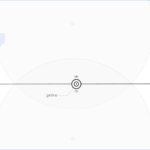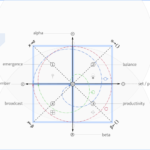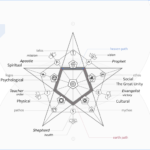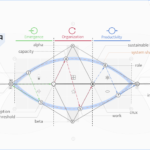Semantic Ontology Framework
The Semantic Ontology Framework (SOF) is a way of thinking about and notation Complex Adaptive Systems. It serves as the framework basis for UK Systematics. A model of models, SOF is concerned with how systems can be designed, developed, understood, and managed. The Framework consists of seven basic systems shapes, with additional advanced shapes, all of which describe dynamics and elements helpful to Systems Thinking and “Quantum Thinking” and could be considered an application of the discipline of cybernetics in its fundamental meaning.1 SOF can also serve as a framework of contextualization to adapt ideas and systems to the Systems VS and Universe VS worldviews of the Emergent Value Systems framework.

The Seven Shapes
The seven systems shapes and their diagrams (called Frames) are evolutionary by design: each shape incorporating and building on the elements of the last. While this illustrates complex systems as an emerging and adapting entity, it also makes teaching systems thinking easier since the learner can begin with simpler ideas and then move into the more complex as familiarity and mastery is achieved.
The Seven Shapes all represent Frames — each one numbering a Frame geometry. Derivative Frames based on one of the System shapes will have their name proceeded by the parent Frame number in square brackets (i.e. [7]). Frames are one type of object in the SOF Universe:
- Element: An individual unit of meaning, composed of at least one symbol, sometimes labeled or named, for assembly into Frames.
- Shapes: Lines, polygons, and associated symbols showing relationship and dynamics in the Frame.
- Node: A position on a Frame with particular focus and meaning, often hyperlinking to significantly more information.
- Area: A portion or approximate location in a Frame, populated by other elements, such as a Phase, or Step.
- Sprite: An element that gives context to the Frame, but is not an active focus or point of major dynamic and interaction.
- Frame: A system of Elements explaining a system or set of systems and their dynamics. While not required for “odd shapes”, most Frames bear the number of the parent systems shape in square brackets. Aberrant or dis-integrative systems are described by [X] Frame and bear the [X] prefix.
- Environment: A contextual system containing a Frame or several Frames in a similar context.
- Workflows: A system, often based on a master Frame, linking a set of Frames related to an integrated work process. Denoted by [W] in the Frame Title.
About SOF
SOF is a fusion of two big ideas about the connection of meaning and being:
semantics: (from Ancient Greek: σημαντικός sēmantikós, “significant”) is the study of reference, meaning, or truth. The term can be used to refer to subfields of several distinct disciplines, including philosophy, linguistics and computer science.2
ontology: (New Latin from compound Greek ὄντος, ontos, ‘being’ or ‘that which is’ and -logia -λογία, ‘logical discourse’) is the branch of philosophy that studies concepts such as existence, being, becoming, and reality. It includes the questions of how entities are grouped into basic categories and which of these entities exist on the most fundamental level. Ontology is sometimes referred to as the science of being and belongs to the major branch of philosophy known as metaphysics.3
“Semantic ontology” is a recognized discipline in the field of computing theory, especially concerning machine learning, artificial intelligence (AI), and cybernetics. The discipline attempts to use semantics to better understand what users mean (as both the creators and consumers of information), and ontologies to structure data and representations based on that meaning.4 SOF, on the other hand, attempts to use similar ideas in human-readable processes to increase people’s empowerment according to the [3] The Three Powers as a resistance to dis-empowering humans in information ecosystems in favor of corporations and advanced machines.
- Version: Current: 3.0 | Working on updating to 3.1, refining problems and adding more connective and dynamic elements.
- Console: The “in-frame” view of the system based on hyperlinked SVGs. Includes navigational system hyperlinked to this Codex.
- SOF Symbology: A list of elements, their symbols and associated styling used to create frameworks and their meaning. Symbols are grouped by framework version.
Posts Related to SOF
ChatGPT Gets SOF Concepts Better Than My Friends
After hearing a lot of chatter about the ChatGPT language model, I decided to try…
The 4 S’s of Showing Up
I’m doing a lot of research right now into being present in parenting, specifically as…
Meta
SOF was developed by adapting an “organic” systems approach to Gospel Movements (i.e. “simple church planting”) to models for organizational change and project management in the consulting work of MuddyHudson LLC and GoAheadLaunch LLC, largely through the work of Kurt Linder, Joe Schlosser, and Ben Cheek.
The core of SOF was developed around the seventh [7] The Matrix shape as a way of contextualizing the Gospel allegorically to all systems in all contexts. This is done through a systems-allegorical reading of the life and ministry of Jesus and his Apostles represented in the [7] The Way of Jesus and the derivative Frame [7] Emergent Leadership.
References & Notes
- Cybernetics is, in laymen’s terms, the science of getting systems to talk cross-disciple by treating all systems as interactive feedback-loops. While the popular definition has to do with applying this to technology and bio-tech, the original discipline was merely a pillar of Systems Thinking. See “Cybernetics” Wikipedia. https://en.wikipedia.org/wiki/Cybernetics
- “Semantics” Wikipedia. https://en.wikipedia.org/wiki/Semantics Accessed 2/6/2022.
- “Ontology” Wikipedia. https://en.wikipedia.org/wiki/Ontology Accessed 2/6/2022.
- See: Semantic Arts Admin “Semantic Ontology: The Basics” semantic arts, April 8, 2019. https://www.semanticarts.com/semantic-ontology-the-basics/ Accessed 2/6/2022.









